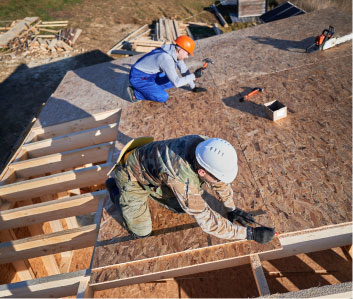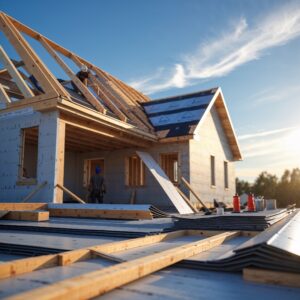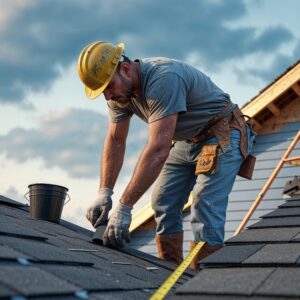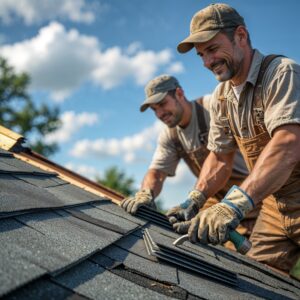Flat roofs are a popular choice for Norfolk homes due to their modern look and space-saving benefits these days. But because of their deep slope structure, they are more prone to water pooling, debris buildup and UV damage compared to pitched roofs. Therefore, homeowners must regularly maintain flat roofs to ensure longevity and avoid expensive repair costs.
It involves specific attention to prevent issues like leaks and structural damage. Regular inspections, debris removal, and, most importantly, proper drainage to avoid water ponding on the residential and commercial flat roofs.
| Common issues with a flat roof Blistering—moisture gets trapped and forms bubbles Water Ponding—water stands and causes leaks. Debris buildup–leaves and dirt accumulate and block drainage. Structural stress from snow and ice. Clogged gutters and drains cause water pooling. |
Tips on How to Maintain a Flat Roof
Norfolk’s fluctuating climate often presents homeowners with several challenges to maintaining the roof’s integrity and durability. Flat roofs, which are cost-effective and add aesthetic appeal to houses, require careful inspections and annual maintenance by professional Norfolk roof contractors. This not only not only saves you from costly repairs and replacement but also provides a healthy living environment.
Regular Inspection to Identify Issues and Repair Promptly
Conducting routine checks to identify potential roofing issues and take prompt action helps extend the lifespan of your roof and protect your Norfolk property. If you notice any significant damage during the inspection, don’t delay it to escalate expensive repair. Address them with DIY approaches or consult roofer experts for your flat roof maintenance.
- Start with a thorough visual inspection of your flat roof surface. Look for signs like cracks, blisters, or tears in the roofing membrane. Pay attention to seams and edges, which can lead to roof leaks.
- After rain or heavy storms, examine the roof for standing water. If it remains for more than 48 hours, there must be an issue with the drainage system.
- Check the interior of the attic or top floor for any water stains or mould growth.
- Inspect gutters and flashings to see whether they are in good working condition or not.
Clear Debris Routinely to Prevent Buildup
Flat roofs are particularly susceptible to debris accumulation because they don’t have the same slope as pitched roofs. This causes leaves, dirt, and branches to stand on the surface. To keep your roof clean from debris, it is better to establish a regular cleaning schedule, ideally two times a month or after heavy storms by yourself or twice a year—once in spring and once in fall from professionals.
- Use a broom or leaf blower to remove leaves, twigs and any other waste that may collect on the surface.
- Focus on areas around drains and edges where debris tends to accumulate and is often ignored.
- Ensure all gutters and drains are blockage-free to allow proper water flow.
- If necessary, fill a bucket with a roof-safe cleaning solution and scrub gently with a soft-bristle brush on areas with stains or algae.
- Rinse with a garden hose or pressure washer on a low setting to wash away any dirt and cleaning solutions you use.
Ensure Proper Drainage for Good Water Outflow
Flat roofs in Norfolk homes are designed with minimal slope, making them susceptible to ponding water. Proper drainage helps reduce the risk of leaks and structural deterioration. Consider installing scuppers or interior drains for extra protection for roofing materials and enhance energy efficiency.
- Clear out any debris that could block the gutter and resist water flow.
- Examine all internal and external pipes to ensure they are free from clogs. Use a plumber’s snake or similar tool to clear any obstruction.
- Evaluate drains placed in low areas to facilitate water runoff.
- If your roof has significant ponding issues, consider consulting a professional to create a slight slope towards the gutter. This may involve adding tapered insulation or other materials.
Taking these proactive steps protects your investment and enhances the overall longevity of your flat roofing system.
Trim Over-Hanging Tree Branches to Reduce the Chances of Moss Growth
Keeping branches trimmed reduces the risk of them scratching or puncturing the roofing material during storms or high winds. This also helps minimise the amount of leaves and twigs that can clog the downspouts and prevent accumulation on residential and commercial flat roofs.
Overhanging branches often promote moisture retention, which leads to moss growth on the contacted surfaces.
- Identify trees near your flat roof that have extended branches over your roof. Aim to keep them away at least 1 meter.
- Prioritise cutting any unhealthy limbs to promote overall tree health.
- Collect and dispose of all the waste to prevent accumulation on your roof.
Maintain Flashings Around Critical Areas to Avoid Leaks
Flashing directs water away from critical areas such as vents and chimneys. These thin materials seal the edges and joints of the flat roof, protecting water penetration inside. But over time, flashing deteriorates, loosens or corrode and reduces the integrity of the structure. This requires timely roof maintenance to prevent further complications.
- Inspect flashing at least twice a year and after severe weather events. Look for cracks, corrosion or loose fasteners. Promptly address any issues to prevent leaks.
- Examine the sealant around the flashing or gaps. Reapply or replace as needed to maintain a watertight barrier.
- Secure any loose flashing with roofing nails or screws and apply around the edges.
- Check for extensive damage and change them with new ones.
Coat Protective Layer to Protect Your Flat Roof From Sun Rays
Flat roofs receive more direct sunlight, which can cause the roofing materials to deteriorate from UV radiation. The heat from the sun can also lead to thermal expansion and contraction, resulting in cracks and weakening of the protective membrane.
Weatherproofing flat roof solutions will shield it from Norfolk’s seasonal temperature changes.
- Coatings with UV stabilisers help protect the underlying material from damaging effects.
- Sun reflective layers also reduce heat absorption, keep indoor temperatures cooler, and lower air-conditioning costs during hot months.
- Regular application of UV-resistant coatings can significantly prolong the life of flat roofs by sealing cracks and preventing water intrusion.
- There are several types of flat roof coatings, such as acrylic, silicone and ure-A-sil, that are ideal for maintaining high stability against exposure to harsh conditions.
- For an eco-friendly approach, install a green roof with vegetation.
Address Roof Leaks to Prevent Water Damage
Flat roofs can develop leaks more easily due to water pooling if not maintained properly. Timely identification for flat roof maintenance and repair can prevent escalating damage.
- First, identify the source. It can be cracks, drains, vents, or any area where water can collect. If you have trouble inspecting the source, conduct a water test.
- Once you find it, fix it immediately. For minor leaks, use roofing cement or a patching material.
- Apply sealant to create a tight water seal.
- Keep an eye on seams for any wear and tear. If there is, reseal it.
- For major issues or significant structural damage, it is best to take a professional roofer who specialises in flat roofs.
| The demand for flat roof waterproofing is expected to increase over the medium term to 2025. After a 13% decline in installation due to COVID-19, the market is again rebounding. In 2024, UK data shows that flat roof value adds a share of 32% of roofing market trends. |
Remove Snow and Ice in Winter Timely Before Structural Deterioration
Accumulated snow can exert significant weight on flat roofs that potentially lead to structural failure or collapse. Each cubic foot of snow can weigh over four pounds when melted which adds up quickly across the roof surface. If snow is left to melt and refreeze it can create ice dams that block the gutters and cause water damage to roof.
To prevent all these issues in Norfolk homes, remove the ice from every roof type especially your flat roof surface as soon as possible.
- Use a roof rake with a long handle to safely pull snow off the roof without climbing onto it.
- If necessary, use a lightweight shovel designed to remove snow. But avoid using metal so that they can damage the roofing material.
- Carefully remove snow in layers. Don’t scrap and dig into the roof surface to prevent damage to the waterproof membrane.
- Consider non-toxic, chloride-free ice melters to help dissolve ice without harming the material.
- Keep an eye on weather forecasts to anticipate heavy snowfall and plan timely removal before conditions worsen.
Schedule Annual Flat Roof Maintenance with Experts to Address Hidden Issues
While DIY maintenance is helpful, having a professional consultation with a trusted roofer and maintaining your flat roof annually will ensure it stays in optimal condition. Expert roofers can identify hidden issues that may not be visible or sometimes ignored by Norfolk homeowners during regular inspections.
Aim to schedule inspections in the spring or fall. This timing allows for assessments after harsh weather conditions and prepares the roof for seasonal changes. Annual maintenance ultimately prolongs the lifespan of your roof and protects your investment.
Conclusion:
Flat roof maintenance is essential for Norfolk homeowners who want to avoid frequent repairs and premature replacement. Taking proactive measures like regular inspection, cleaning and seeking the expertise of Norfolk roofing contractors to manage timely repairs can extend the lifespan and maintain the integrity of your flat roof.
FAQs
Are flat roofs high maintenance?
Flat roofs require consistent maintenance and repairs due to their vulnerability to water pooling and debris buildup. This can cause potential leakage and moisture damage, making it necessary to thoroughly inspect and clean to improve their performance and prolong life expectancy.
How often should you seal a flat roof?
Flat roof refurbishment needs resealing every 5 to 7 years to maintain its protective qualities and avoid water damage. However, this frequency can vary depending on the roof condition and local climate.
What is the life expectancy of a flat roof?
Flat roofing generally lasts between 20 and 30 years with regular maintenance and prompt repair solutions. This lifespan depends on the material you choose, but with more favorable conditions, you can extend it up to 50 years.




